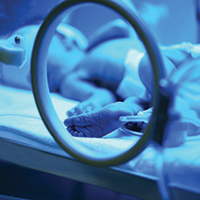Late delivery of macrosomic baby: $5.5M settlement

After a woman was admitted to the hospital, her labor was complicated by very slow progress, maternal fever, and multiple fetal heart-rate (FHR) monitor strip abnormalities. A baby boy was born by cesarean delivery 26 hours after the mother's admission, weighing almost 11 lb. At birth, the baby was asphyxiated, with an arterial cord blood pH of 7.01 and a base excess of -14.4. He was resuscitated and sent to the neonatal intensive care unit (NICU). Nine days after birth, he began to have seizures. The placental pathology report revealed infection; placental cultures grew Group B strep. The infant was diagnosed 6 days later with hypoxic ischemic encephalopathy after magnetic resonance imaging.
PARENTS' CLAIM:
The ObGyn and hospital failed to recognize that the baby was macrosomic. The ObGyn should have delivered the baby when the FHR monitor first showed fetal distress.
DEFENDANTS' DEFENSE:
The case was settled during the trial.
VERDICT:
A $5.5 million Washington settlement was reached.
Size of perineal tear and its consequences disputed: $1.8M verdict
A 34-year-old woman gave birth vaginally. During forceps delivery, she suffered a 4th-degree perineal tear, running from her vagina to her rectum, which was misidentified by the ObGyn as a 2nd-degree tear. The perineal tear lead to complications including infection and a persistent rectovaginal fistula. She underwent several operations over the next 5 years.
PARENTS' CLAIM:
The ObGyn did not appropriately address the wound. Had a cesarean delivery been performed, the wound would not have occurred.
DEFENDANTS' DEFENSE:
The decisions to allow labor to continue and to use forceps were reasonable. The ObGyn contended that the patient sustained only a 2nd-degree tear in the delivery room, with the 4th-degree tear occurring the next day due to attenuated tissue.
VERDICT:
A $1.8 million Illinois verdict was returned.
Related article:
Develop and use a checklist for 3rd- and 4th-degree perineal lacerations
Macrosomic baby, cerebral palsy: $5.5M settlement
At 42 weeks' gestation, a mother was sent to the hospital in labor. During delivery, thick meconium was encountered. At birth, the baby weighed more than 9 lb. At age 16 years, the child has cerebral palsy, a seizure disorder, and developmental and cognitive deficits. She functions at the level of an 8-year-old child.
PARENTS' CLAIM:
The ObGyn and nurses did not deliver the baby in a timely manner by cesarean delivery. The estimated weight and a deteriorating in utero environment, as evidenced by the thick meconium, caused the child's brain injury.
DEFENDANTS' DEFENSE:
The case settled during trial.
VERDICT:
A $5.5 million Illinois settlement was reached.
Did baby get Group B strep from her mother?
During prenatal care by an ObGyn, a woman underwent a routine test for Group B strep, the results of which were negative. The child, with APGAR scores of 9 at 1 and 5 minutes after birth, was admitted to the well-baby nursery. Four hours after birth, the baby appeared to be in distress and was moved to the NICU. She was found to have respiratory distress, metabolic acidosis, and sepsis, allegedly caused by Group B strep, and was placed on a ventilator and prescribed medications. When the baby's condition worsened, she was transferred to a children's hospital. She was discharged 3 months later with bronchopulmonary dysplasia and a chronic lung disease that requires continuous treatment.
PARENTS' CLAIM:
The baby's injuries were attributable to Group B strep. The ObGyn's prenatal treatment did not meet the standard of care.
PHYSICIAN'S DEFENSE:
There was no negligence on the part of the ObGyn. The standard of care was met.
VERDICT:
An Alabama defense verdict was returned.
These cases were selected by the editors of OBG Management from Medical Malpractice Verdicts, Settlements & Experts, with permission of the editor, Lewis Laska (www.verdictslaska.com). The information available to the editors about the cases presented here is sometimes incomplete. Moreover, the cases may or may not have merit. Nevertheless, these cases represent the types of clinical situations that typically result in litigation and are meant to illustrate nationwide variation in jury verdicts and awards.
Share your thoughts! Send your Letter to the Editor to rbarbieri@frontlinemedcom.com. Please include your name and the city and state in which you practice.

